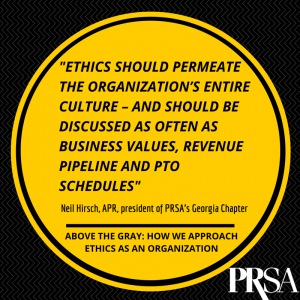During a media interview, your CEO misstates a key fact about your firm’s product capability, making it sound far more advanced than it really is. It was purely an accident and was not intended to mislead, but the fact is now part of the published story. What should you do?
- Nothing. It’s too late to fix.
- Send a letter to the editor asking for a printed correction.
- Send a notice to your customers making them aware of the mistake.
- Both B & C above.
This is a question from PRSA’s updated version of the Ethics Quiz – read on to see if you answered correctly and if you had the same reasoning. Throughout September, PRSA hosted nationally a month of activities in recognition of Ethics Awareness Month. But like anything with a designated time of “awareness,” it shouldn’t mean we relegate the focus and conversation only to those days or weeks. Ethics in our industry, more than anything else, is truly a 24/7/365 commitment.
As a Society, we represent the very largest and smallest of enterprises worldwide. Issues such as transparency, privacy and personal identity are now far more challenging, thereby increasing our responsibility as public relations professionals. Transparency is part of the larger conversation around ethics, which frames it with other such conventions as truth, accuracy, fairness and a responsibility to the public. While it’s tempting to think of ethics as the domain of philosophers debating theoretical concepts, the reality is that we all face ethical decisions every day, and they are almost never black and white.
The rise of digital communications and social media – in general, the Internet of everything – has created a host of ambiguities which cause even the most principled among us to vacillate. The challenge comes in operating in the gray zone – ethical decisions are not always simple nor is there always a clearly “right” answer. An organization’s strong ethical culture provides a foundation to stand strong, no matter how conflicting the winds of change.
A recent Harvard Business Review article discussed how unethical behavior becomes a habit, but how addressing it head-on makes a difference: “When moral standards are unclear or unenforced, it’s easy for employees to feel emboldened to engage in questionable behaviors that are readily rationalized. Environments that nudge employees in the right direction, and managers who immediately identify and address problems, can stop ethical breaches before they spiral out of control.”
Strong ethics begin at the top, where executive leadership sets the tone and tolerance level for behavior. Ethical leaders:
- Establish a Code of Ethics for employees to use as a guide for behavior and self-management.
- Champion ethics training for new employees and annually organization-wide to translate theory into practice.
- Make sure internal communications reinforce ethics guidelines and celebrate examples of ethical behavior.
- Identify an internal or external ombudsman to serve as a resource for employees as they face ethical challenges. Uphold anonymity.
It shouldn’t be a taboo topic that only emerges when an issue arises. Albert C. Pierce, professor of ethics and national security at the National Defense University in Washington, outlined in a talk to Santa Clara University’s Markkula Center for Applied Ethics four abilities that organizations should develop in employees. To paraphrase here:
- Moral awareness to understand when a problem starts to have a dimension of right and wrong.
- Moral reasoning to be able to think through the problem, project the consequences, then decide what to do within the deep complexities of an issue.
- Moral courage to overcome the fear of an ethical answer that is not easy to implement.
- Moral effectiveness to positively persuade someone else to choose the most ethical action.
As public relations professionals, we are in a unique position of influencing decisions not only for our team, but for our clients or organizations. How do we make sure our ethical center is strong enough for the both of us? It starts with a solid understanding of our professionals’ ethical standards and values.
The answer to the earlier question is D: Both B & C. PRSA states: Even though the mistake was unintentional and correcting this information may prove embarrassing to the executive, failure to promptly correct erroneous information delivered to the news media would not be in keeping with the PRSA Code of Ethics professional values of Advocacy, Honesty, Independence and Fairness.
It’s really worth the three minutes it takes to run through the Ethics Quiz. You may be surprised by a couple of the answers —and perhaps you’ll be better prepared the next time you face an ethical challenge.
Neil Hirsch, APR, is president of PRSA’s Georgia Chapter and global external communications manager of Novelis.







